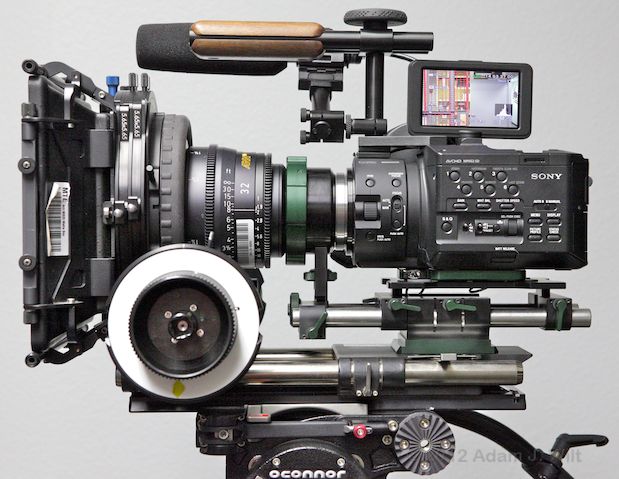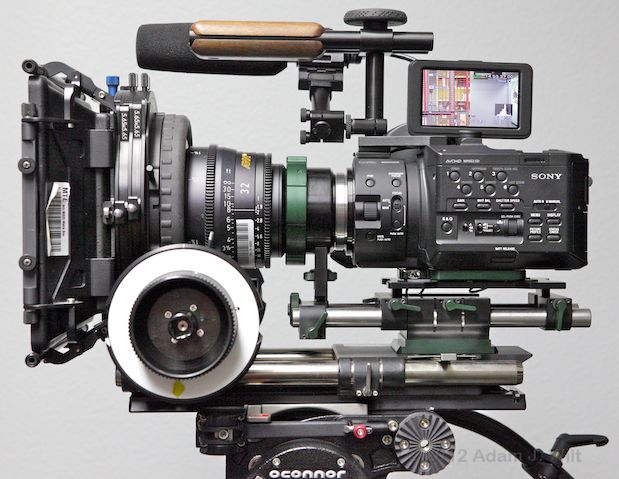
NEX-FS100 with ShotGrip handle; Hot Rod PL Tuner-S kit; Arri 32mm Ultra Prime, matte box, and follow-focus.
The protean design of the NEX-FS100 cries out for customization, and the market responds… Whether you want a more comfortable and stylish top handle, a simple lens adapter, or a full-on, ruggedized wrap-around support system capable of mounting the heftiest cine zoom, somebody makes it. Let’s take a look at some of the options available.
I don’t wish to imply that I’ve made an exhaustive survey of the field—any such survey would be quickly out of date in any event. Rather, I’ve tried to collect a reasonable selection of FS100-specific accessories and E-mount adapters, to show what’s out there and to spark your imagination. Some of these things I’ve used, others I’ve just read about. If I’ve missed anything you think folks should know about, please add a comment with a pointer to the deserving bit of kit.
Top Handle / Cheeseplate
Some find the FS100’s supplied handle to be suboptimal, and the placement of the camera’s topside accessory mounts, just in front of the LCD, makes it difficult to attach accessories directly to the camera.
Berkey System has a top-mounted cheeseplate for $225. It bolts into the camera’s top mounts, adding multiple attachment points forward of the LCD where they’re more useful. It works with the camera’s original top handle, or with Berkey System’s own modular handles and rig bits.
Caleb Crosby’s “ShotGrip” top handle / cheeseplate combo is available from Shooting Machine for $225.
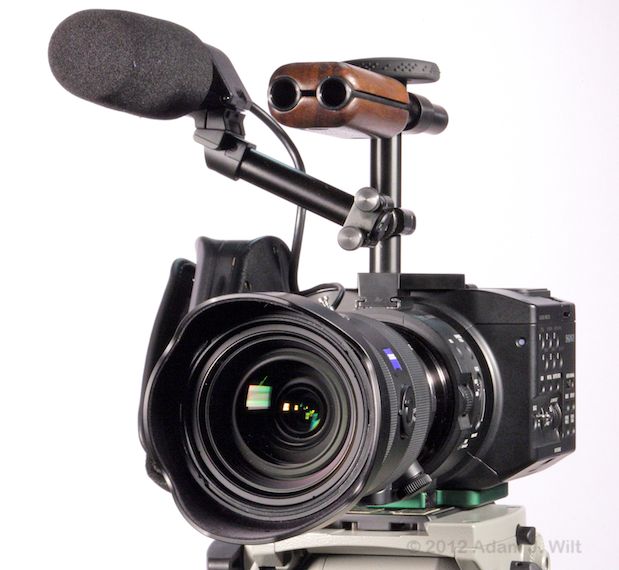
ShotGrip with 7″ shortie rods and dual stub clamps rigged to support the FS100’s original mike holder. Sony 24-70mm f/2.8 lens on LA-EA1 A-mount adapter.
The ShotGrip cleverly uses a 15mm diameter handle riser and dual 15mm rods for the handle itself, allowing lots of real estate for accessory clamps. A black walnut handgrip is secured to the horizontal rods with two clamping screws, making a comfortable and stylish handle.
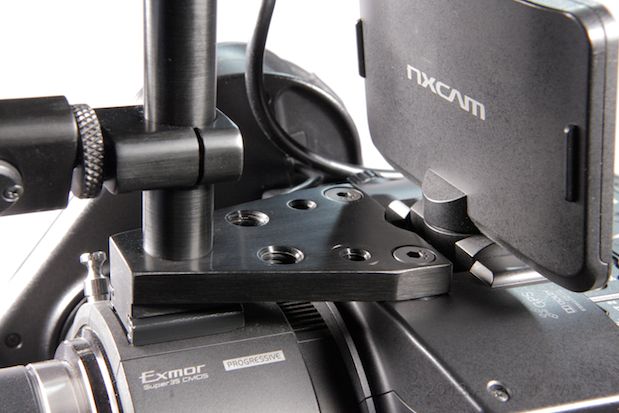
The ShotGrip’s cheese plate with two 1/4″ and two 3/8″ sockets.
The handle itself screws down into the frontmost 1/4″ socket on the top of the FS100, feeding through the cheese plate. The handle riser’s tapered base wedges into the cheese plate, securing the handle against unwanted rotation. The handle has a large, rubberized knob on the top: it’s this knob that screws down the clamping mechanism, making it easy to reposition things without tools. Loosen it, and you can rotate the entire handle and slide the rods back and forth.
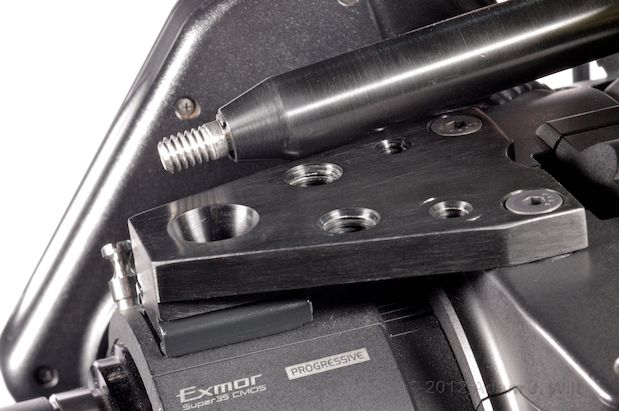
The ShotGrip’s tapered riser wedges firmly in the cheeseplate.
Shooting Machine also offers stub clamps, $50-$65, for hanging bits ‘n’ bobs off the ShotGrip (or any other 15mm support rod). I used a pair to mount the FS100’s mike holder, both on the riser and on the top handle itself. The system works quite well, though you do have to tighten the bejeezus out of things to prevent parts from coming loose and rotating at inopportune moments.
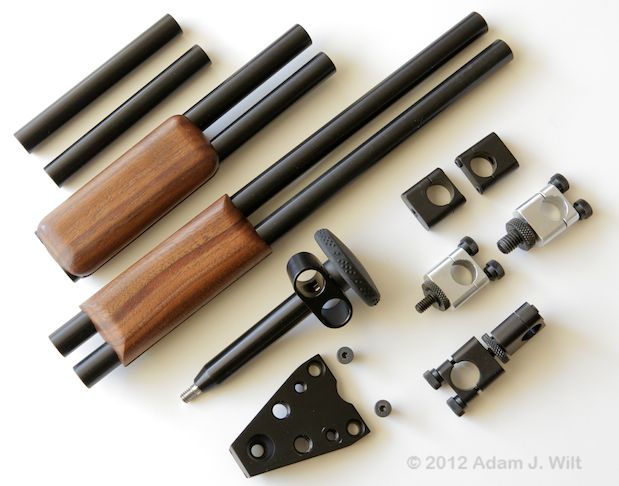
Shooting Machine gear: 4.5″ rods, 7.5″ shortie handle, 12″ full-length handle, handle riser, cheeseplate, assorted stub clamps. A ShotGrip system contains one handle, handle riser, and cheeseplate with its two bolts; extra rods, handle parts, and clamps are available a la carte.
Now, if only Mr. Crosby would consider making a contoured, Aaton-style, black walnut handgrip…
Still-Camera Lens Adapters
The FS100’s E-mount is only 18mm deep. That’s shallow enough to allow adapters for almost any lens mount used on lenses capable of covering the FS100’s image circle.
Sony has a pair of A-mount adapters for Alpha lenses: the $200 LA-EA1 with electronic iris control, and the $400 LA_EA2 which will (with an upcoming FS100 firmware update) provide both iris control and autofocus.
Those with Canon EF glass should investigate the Conurus / Metabones EF to NEX adapter, $400, which is supposed to allow iris control, lens metadata capture, and image stabilization. EF lenses are entirely electronic, so electronic iris controls are necessary; this adapter looks very nice indeed, though I haven’t had a chance to use one.
Metabones also offers adapters for seven other lens mounts, in the $65-$120 price range; they’re purely mechanical adapters, without any control capability, but they all use chromed brass mounting surfaces for a precise and long-lasting fit.
Germany’s Novoflex offers the NEX/NIK Nikon G to E-Mount adapter for €169 (around $230), as well as adapters for fourteen other still-camera lens mounts, both 35mm and medium-format. Novoflex stuff is pricey, but it’s well designed and precisely crafted. I’ve used Novoflex adapters a couple of times and been impressed with the quality.
The NEX/NIK adapter, along with the other Nikon adapters I’ll mention, includes manual iris control through mechanical manipulation of the iris-actuation lever; it works equally well on G or D series lenses. It does not use electronic control, nor does it convey data or power to or from the lens.
MTF Services Ltd in the UK makes a Nikon G to E-mount adapter for £265, about $420. I have no experience with MTF, but have heard several people recommend these adapters.
“All fine and well”, I hear you saying, “but these are a bit rich for my blood. Isn’t there anything cheaper?” Why, yes, of course there is. There are lens adapters in the $23-$40 range, if you’re willing to, um, make some compromises. I am a cheap bastard myself, so I have explored these affordable options!
Both RainbowImaging and Fotodiox offer inexpensive adapters for almost any lens mounts conceivable.
I bought the RainbowImaging Nikon G to E-mount adapter, $40 on Amazon, at the same time as I purchased a Fotodiox Nikon G to MFT adapter for my GH2.
The RainbowImaging adapter appears to be made of soft aluminum, though it has a chromed mount for the Nikon lens. The lens fits nicely on the mount and the mechanical iris control works well, though the lens has perhaps half a millimeter of play forwards and backwards (it’s perfectly snug side-to-side).
It didn’t fit on the FS100.
Its E-mount flanges were just a bit too big to fit the camera. Never mind: it’s soft aluminum! Fifteen minutes with a flat file, taking off the outermost 0.5mm or so, was enough to allow a proper fit (if you try such a thing, be very certain you clean any filings out of the mount before putting it on the camera; I washed it out and sprayed it compressed air after each round of filing before getting it anywhere near the FS100!). Yeah, a milling machine would have been faster, but I don’t have a milling machine: like I said, I’m a cheap bastard.
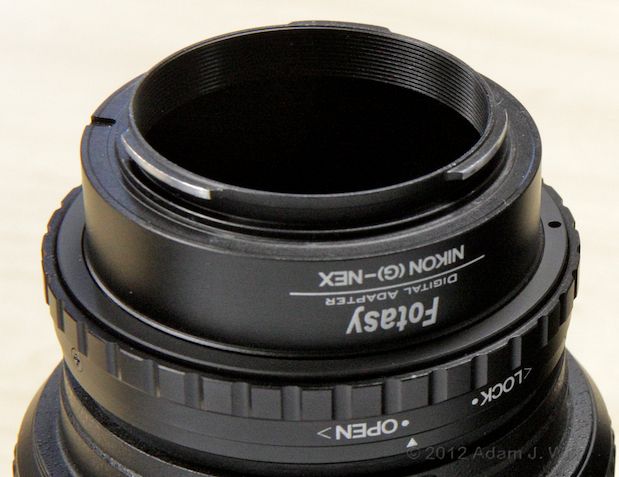
The $40 adapter on a Nikon 17-55mm. Note the filed-down flanges.
Yes, the adapter is labeled “Fotasy”, not RainbowImaging. Hey, it’s only forty bucks, whaddya want?
Now, that $40 Fotodiox adapter for the GH2 didn’t work out so well. The lens had a lot of slop on the adapter, both laterally and longitudinally (though the adapter itself fitted very snugly and securely on the GH2); I couldn’t even touch the focus ring without causing the image to jump. Furthermore, when the lens was locked in place, the iris control didn’t let the iris open all the way. I returned it, and got the RainbowImaging Nikon G to Micro Four Thirds adapter for $23, instead.
This adapter came in the same sort of plain-white box as the RainbowImaging NEX adapter, and it has the same minimalist instructions, printed on a tiny slip of paper reminiscent of a Christmas cracker joke or a slightly oversized fortune-cookie fortune. Yet it doesn’t say “Fotasy” on its body; its iris ring has much finer knurling; it uses different screws to attach its Nikon mount; its labeling uses a different font. It fits very tightly on the lens, with no slop at all… perhaps a little too tightly. Hey, it’s twenty-three smackeroos, whaddya want?
I mention all this not to dump on Fotodiox or on RainbowImaging, but to show that for $23-$40 you’re not going to get the same level of precision, consistency, and robustness as with higher-priced mounts. You really do get what you pay for… and you pay for what you get. TANSTAAFL.
I consider these low-cost adapters to be perfectly suitable for casual use, but if I planned on doing serious production on an ongoing basis with Nikon lenses on E-Mount and MFT cameras, I’d invest in the MTF or Novoflex adapters mentioned above.
PL-Mount Adapters
PL mounts are the Next Step Up; PL adapters have their own locking collars (PL is a breech-lock, not a bayonet mount), back-focus adjustment through shims, and (often) provisions for external support. PL lenses tend to be big and heavy compared to stills lenses, and their mounting flanges reflect that difference in mass and the forces generated thereby:
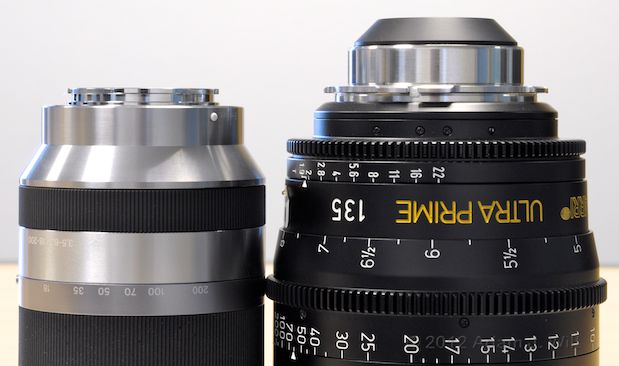
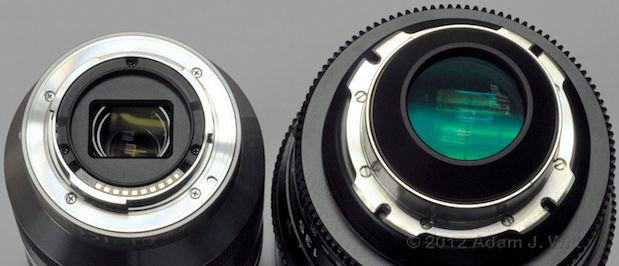
Two views of an E-mount lens (Sony 18-200mm, left) and a PL-mount lens (Arri 135mm Ultra Prime, right).
You would expect that a PL-mount adapter might cost a bit more. You would be correct.
MTF Services Ltd has a standalone PL-mount to E-Mount adapter for £350 ($590 from Abel Cine). It’s the only one I’ve seen that isn’t set up to tie into iris rods or other supports; it appears to depend entirely on the E-mount for its attachment.
16×9’s Cine Lens Mount – E-Mount & Support, $870, includes a support bracket for 15mm rods, offering a modicum of additional support.
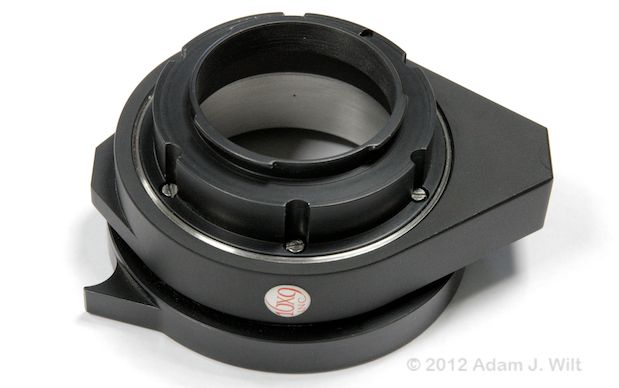
The 16×9 PL-mount adapter can be shimmed between its main body and its E-mount ring.
Solid Camera has a standalone PL Mount Adapter for $695; it has a separate 15mm support bracket, for $225.
Hot Rod Cameras has the Hot Rod PL-E mount; it appears to be available only as part of the Tuner-S Kit described below.
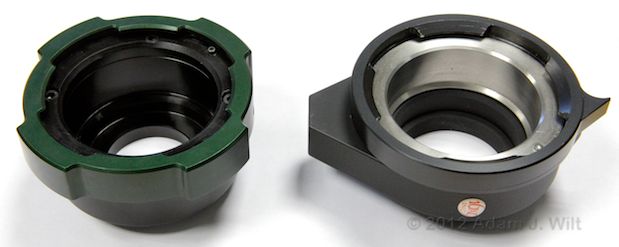
PL-mounts from Hot Rod Cameras and 16×9; supports not shown.
Next: Build-up kits; EVFs; Sample Setups…
Camera Build-Up Kits
In addition to its cheeseplate, Berkey System sells an FS100 Baseplate for $475.
Redrock Micro’s $1383 Studio Bundle for Sony FS-100 includes a riser baseplate, 15mm rods, matte box, follow-focus (without lens gears), and an accessory arm.
Zacuto’s $3515 FS100 Filmmaker Kit is a handheld support kit; it includes baseplate, riser, shoulder pad, handgrips, EVF arm, “Zwiss plate” cheeseplate, and follow-focus (with ZipGear lens gears), but no matte box.
The above kits are lens-agnostic; you’ll need to provide your own lens adapter if you aren’t using E-mount lenses. If you want kits with PL adapters as part of the package, there are at least two such available.
Illya Friedman at Hot Rod Cameras has the PL Tuner-S Kit for FS100, $1799 list (but check the website; sometimes HRC has deals on demo gear). It includes an FS100-specific riser plate, an adjustable-height 15mm rod adapter, sliding baseplate, and a PL adapter with a robust 15mm support bracket.
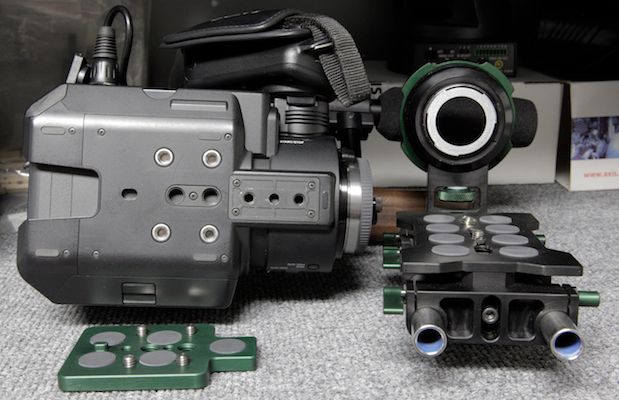
Hot Rod’s FS100 plate bolts into the four lateral sockets, for a very robust and rigid attachment.
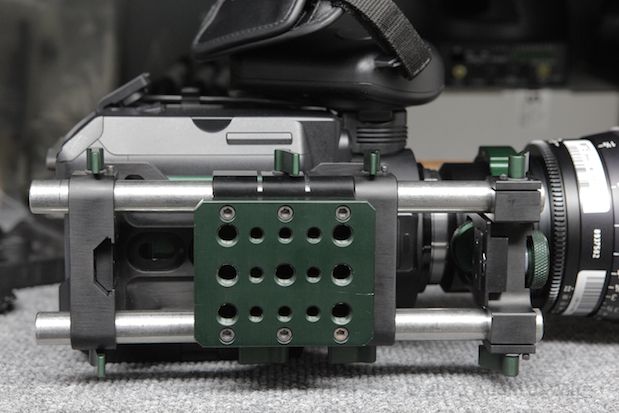
Hot Rod kit fully attached to the camera.
Building the kit is the work of a few minutes; it’s not something you just pop the camera on and off of heedlessly. You first screw in the camera riser plate, then attach it to the rod adapter using two screws underneath. Getting to those screws usually means sliding the rods out of their brackets and removing the baseplate (the big green lump in the picture above). After tightening down the rod adapter, the naive user then puts the rods back in, and attempts to slide the lens mount on… before realizing that the mount needs to twist on, as it’s a bayonet and not a breech-lock! After removing the rods (again) and fitting the mount, the rods are reinserted (being sure not to forget the sliding baseplate), and all the adjustment screws are fiddled with to make everything line up at the right height.
Once this fiddly adjustment is done and the screws locked down, subsequent removals / refittings proceed rather more quickly, grin.
(The point to this, of course, is not that the Tuner-S kit is especially complicated. All build-ups of this sort take a while to bolt on; don’t expect ’em to be as quick to install as a screw-in filter!)
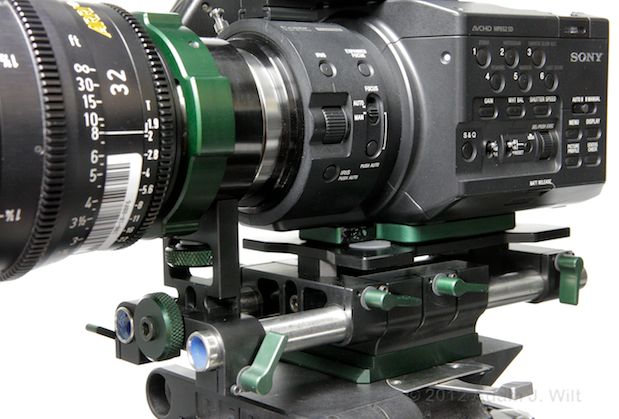
The Hot Rod rig, built, mounted on a RED 19mm dovetail adapter, with a 32mm Ultra Prime loaded.
The Tuner-S kit shows the attention to detail that users of Hot Rod Cameras gear have come to expect: locking levers have stopper bolts so they don’t unscrew more than one turn; knurled knobs are used where possible for tool-free tweaking; things line up properly; fit and finish are top-notch. The mount support is worth a close look; it’s not the usual here’s-an-adjustable-center-post deal, but a rigid, machined support that attaches securely and positively to the base of the mount.
“Now how much would you pay? But wait, there’s more…” If the Hot Rod Cameras rig still seems a little bit on the lightweight side; if you’re uneasy about directly attaching a massive cine zoom to that delicate little E-mount: Carlos Acosta at Solid Camera has designed what may be the ultimate FS100 build-up kit. It’s $3500 fully equipped, including top cheeseplate, bottom riser with “knuckle” side plates, 16×9 dovetail adapter, dovetail plate, fluid-damped EVF mount, quick-release top handle, lens mount adapter, and lens mount.
I saw prototypes at last November’s Entertainment Technology Expo in Burbank:
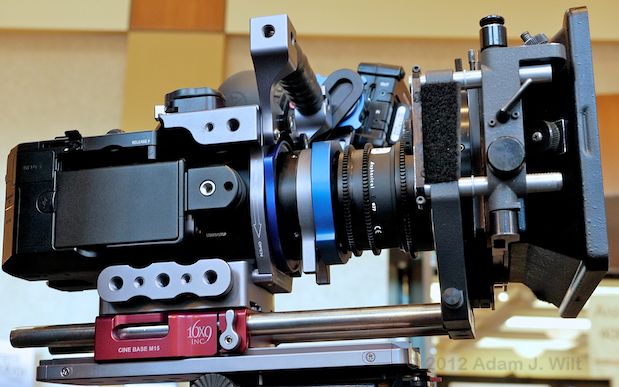
Right side view: FS100 wrapped in top and bottom plates, lens mount in front, 16×9 dovetail adapter, and dovetail plate.
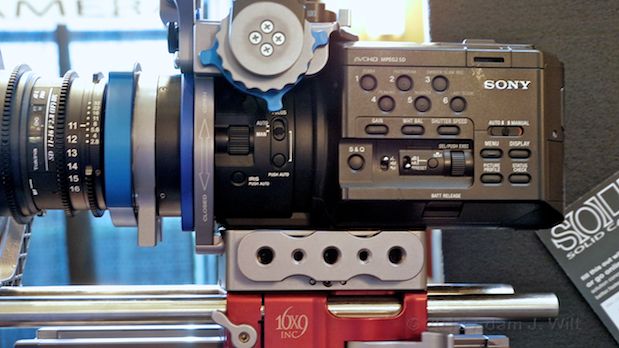
Left side view: note adjustment knob for EVF arm.
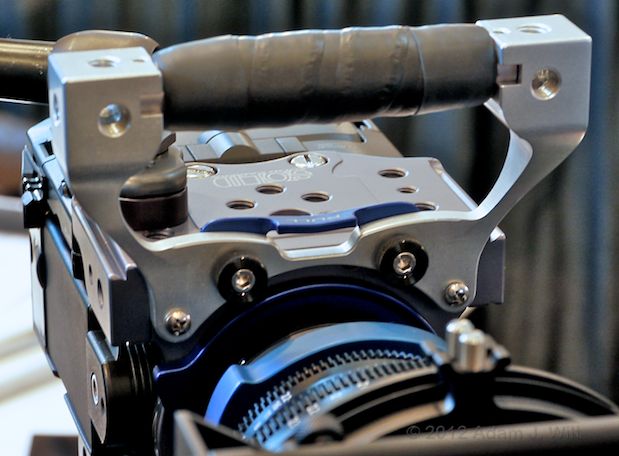
Top plate and massive quick-release carrying handle, with its own accessory sockets.
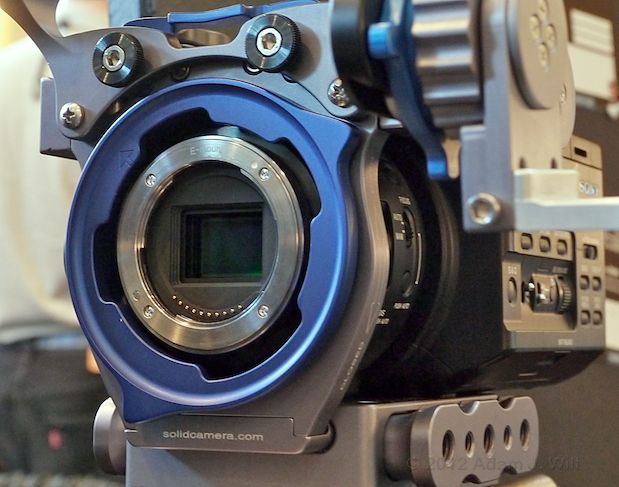
Lens mount adapter (not the lens mount itself!) ties into both the top and bottom plates, forming a rigid cage.
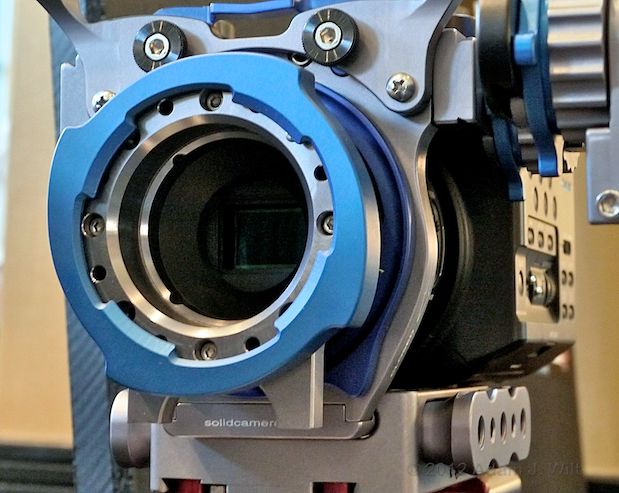
The PL double-lock mount clamped in the mount adapter with the adapter’s own robust breech lock. It doesn’t depend solely on the E-mount for mechanical support.
The Solid Camera exoskeleton takes the weight of the lens off the E-mount, and distributes it to the mounting points spread across the camera’s surface. This is one heavy-duty lens adapter.
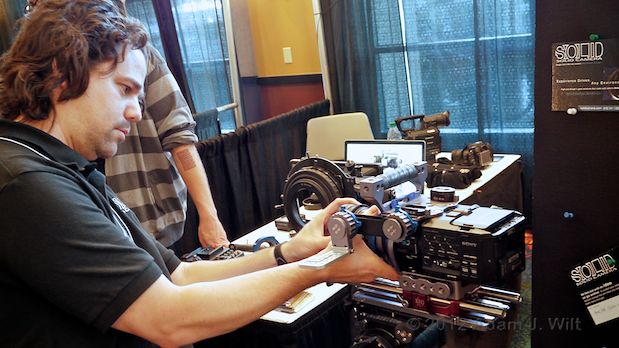
Solid Camera founder Carlos Acosta attaches a lens.
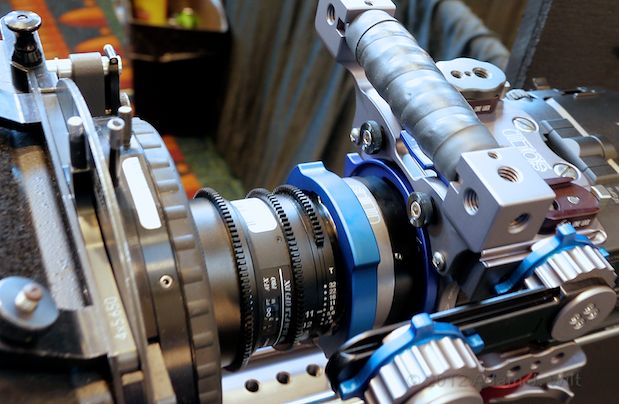
Duclos-converted Tokina 11-16mm fitted to the PL mount.
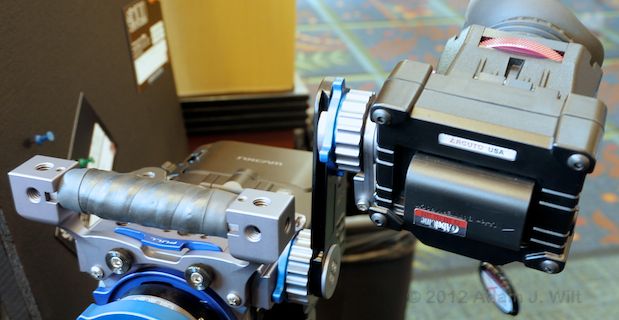
Fluid-damped EVF arm with a Zacuto Z-Finder EVF attached.
This EVF arm is highly adjustable, yet it locks firmly in place. Nice work.
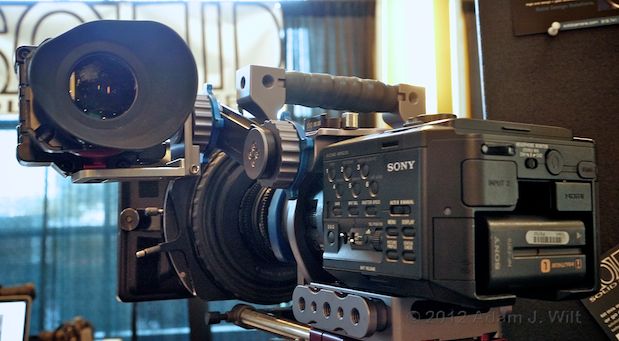
Fully-rigged FS100, ready for some eye-level action.
EVFs
As the Solid Camera rig implies, and any attempt to use the FS100 as a shoulder-braced camera clearly shows, you’re going to want some sort of repositionable EVF: the top-mounted LCD works wonderfully on a tripod or Steadicam, not so well for eye-level, body-braced handheld.
There are two product lines I know of that seem ideally suited for the purpose, Cineroid’s EVF, $550, and EVF Metal, $870; and Zacuto’s Z-Finder EVF and EVF Pro, $770-$950 (street prices).
(That takes care of the operator, but if the focus-puller needs a monitor, you could do worse than the $1500 VFM-056W or the $2500 LVM-074W from TVLogic. I’ve played with the VFM-056W at trade shows, and it seems OK, but my current favorite 1st AC monitor is the LVM-074W, despite the additional cost and size. I’ve used it on a couple of gigs, and now I pine for one myself, even if I am a cheap bastard.)
Sample Setups
Just for fun, here are some of the kits I put together from the bits that were supplied for review and bits we had lying around. Some are serious, some are senseless; I show them more to start the thought process than as models for emulation. The usual disclaimers apply.
Usual Disclaimers
None of these rigs has been approved by their manufacturers. Driver of questionable sanity on closed course. Do not try this at home. Void where prohibited by law. Neither Adam Wilt nor Createasphere will be held liable for any injury, equipment damage, ridicule, or other losses suffered. Proceed at your own risk. You get the idea.
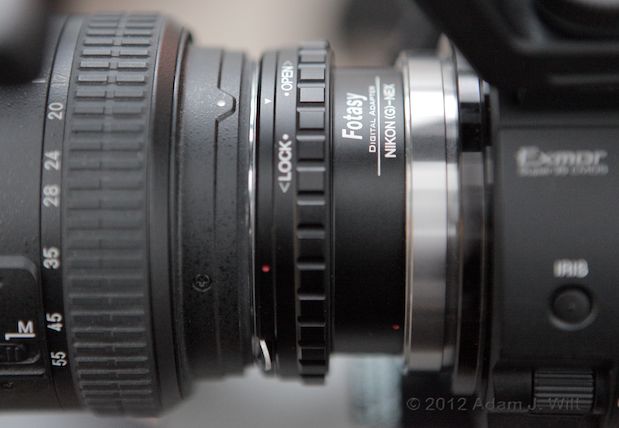
Nikon 17-55mm F/2.8 attached with RainbowImaging adapter. Note the iris control ring.
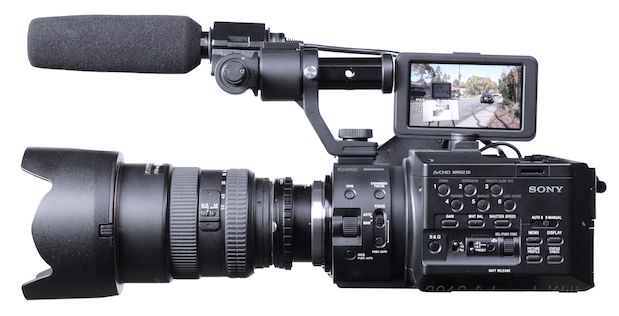
The FS100 with Nikon 17-55mm. This was actually a fairly reasonable setup.
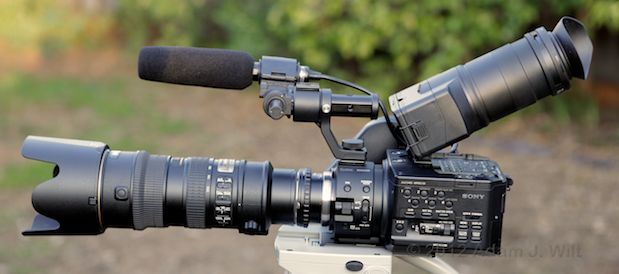
FS100 with Nikon 70-200mm f/2.8. This was not a reasonable setup; it really should have had additional lens support. It worked, but I was very careful not to yank the camera around with all that weight cantilevered off the E-mount alone. Do not try this at home.
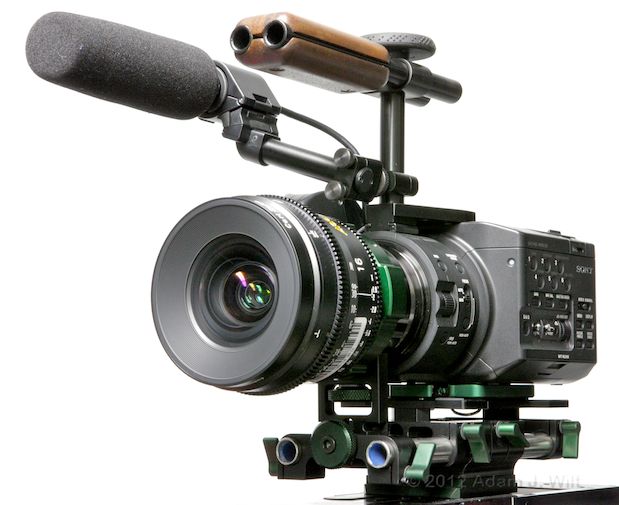
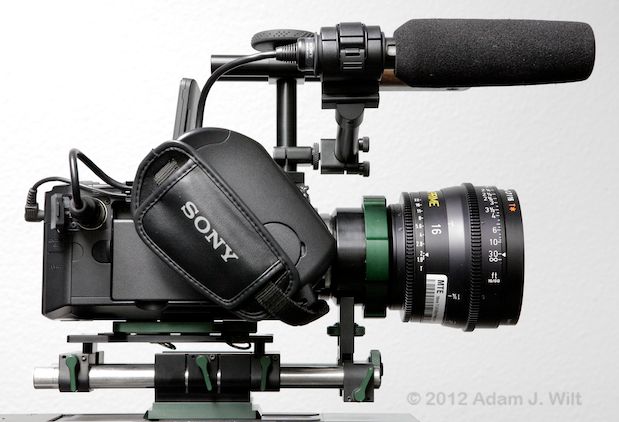
Two views of the FS100 with Hot Rod Tuner-S kit, ShotGrip handle, and Arri 16mm Ultra Prime.
Here’s a built-up Tuner-S kit, mounted on an O’Connor quick-release plate. In normal operation there would be a lot of additional gumpf added on (follow focus, matte box, assist monitor, and enough random cables, arms, clamps, and brightly-colored bits of camera tape) to make it a real camera, but I wanted to show off the core components.
This was my preferred ShotGrip rig, using two stub clamps connected back-to-back to mount the 15mm stock microphone mount to the 15mm handle riser. I had to tighten the locknut on the stub clamp’s stud just as hard as I possibly could, otherwise the mike mount would come loose and flop down.
On a real-world shoot I’d dump the stock mike clamp for a suspension-type shockmount, or (preferably) move the mike off-camera entirely, but I wanted to use what I had, and explore the versatility of the FS100’s stock components as much as possible.
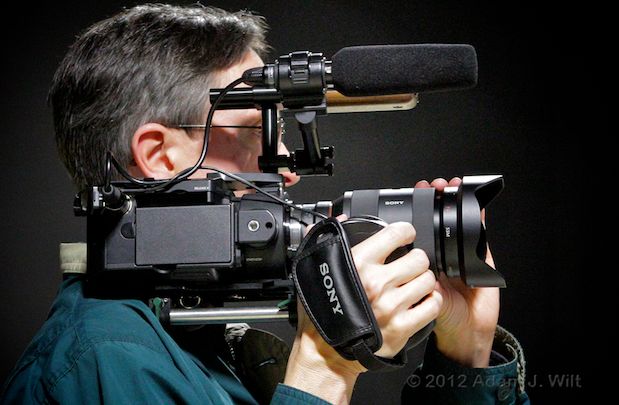
FS100, Sony 24-70mm f/2.8 on LA-EA1 adapter, Hot Rod rod adapter, Shooting Machine ShotGrip and stub clamps.
Here, I tried to mock up a compact handheld rig. The Hot Rod Cameras rod adapter holds a 15mm rod, and I used it and one of the Shooting Machines 1/4″ female stub clamps to relocate the FS100’s handgrip farther forward and lower down. This resulted in a compact, very stable shoulder-braced package. If only I had a viewfinder, it would have been perfect!
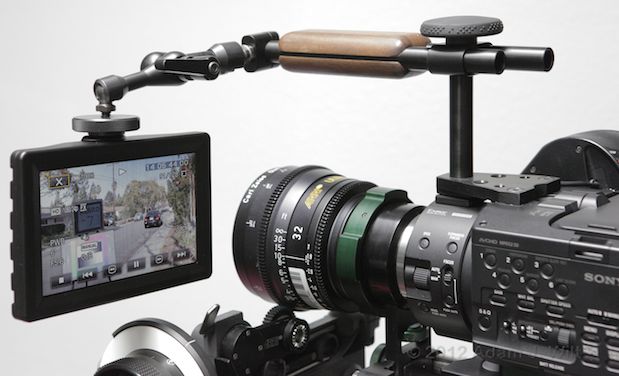
RED 5.6″ LCD attached to ShotGrip with a stub clamp and a RED arm. (LCD image Photoshopped in.)
Here’s one solution to the problem: hang a small display off the front of the ShotGrip. Not having a suitable small display, I stole an LCD off one of our RED ONEs for demonstration purposes, and Photoshopped in its image.
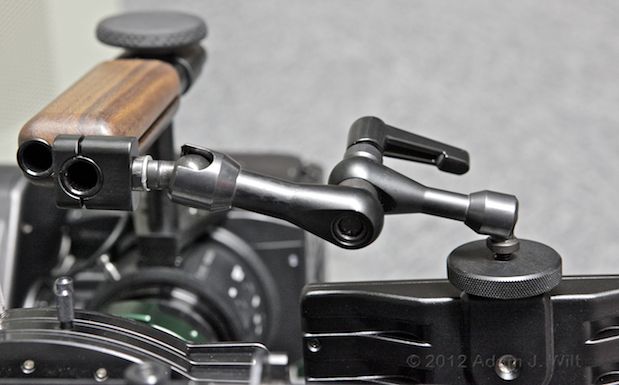
Stub clamp mounted to ShotGrip handle rod; LCD mounted to arm.
All I had to do was loosen the ShotGrip’s rubber knob, unscrew the handle slightly, and slide one of the two top rod forwards, so I could add a stub clamp.
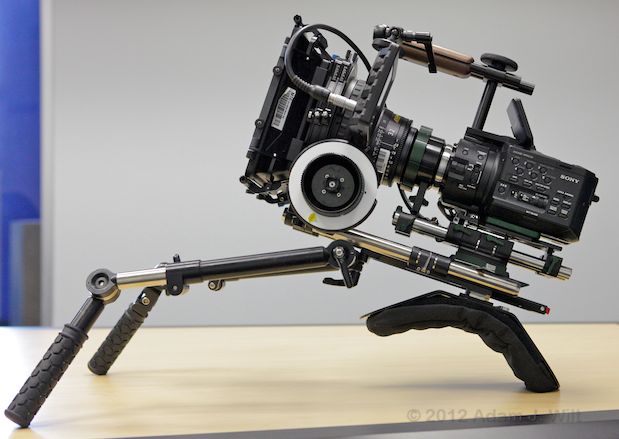
Shoulder-mount build-up: Hot Rod Tuner-S on RED 19mm supports; Arri 32mm, matte box, and follow-focus; ShotGrip handle with simulated (RED) LCD; all atop Element Technica Mantis rig.
A more serious rig; an attempt to build up a full, cine-style handheld kit. With a heavy PL-mount lens, simply moving the FS100’s handgrip forward wasn’t going to suffice. The Mantis rig provides a stable, three-point support, and I used our existing 19mm support rods for the matte box and follow-focus.
The RED LCD served to demonstrate viewfinder placement; I’ve operated our RED ONE in a similar configuration and prefer the free-standing LCD to an EVF pressed to my eye on this sort of rig.
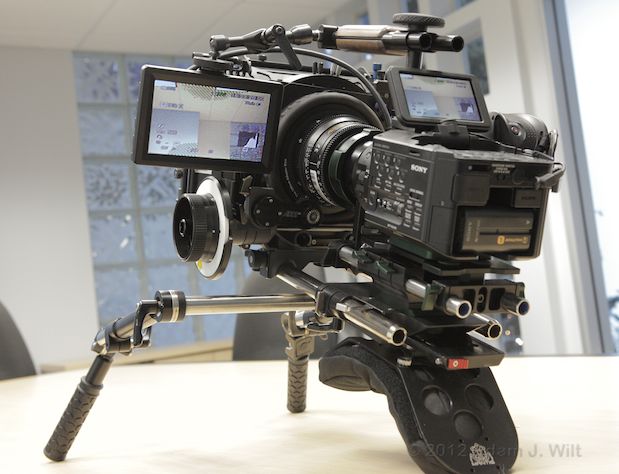
Another view of the handheld rig. LCD image photoshopped in.
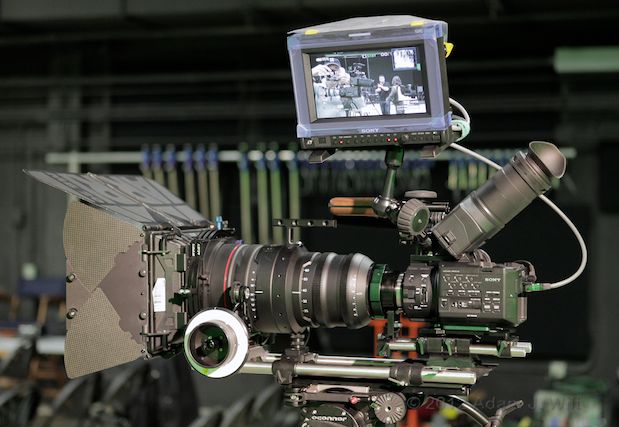
Studio kit: RED 18-85mm T2.9, Sony PWM-740 OLED monitor on Manfrotto hydro arm.
Buried in all that stuff is the Hot Rod Cameras Tuner-S kit and the ShotGrip handle and cheeseplate. The 18-85mm has the Optitek lens support, and the whole assemblage is mounted on an Element Technica dovetail plate using the RED dovetail adapter screwed directly into the Hot Rod Cameras sliding base.
The $10,000 RED 18-85mm T2.9 zoom is a good match for the FS100; it’s a comparatively affordable cine zoom with better optical performance than the price would suggest (its zoom and focus mechanisms aren’t silky-smooth as on higher-end lenses, it’s a bit on the delicate side, and it needs to be stopped down past T4 or T4.8 for best contrast; if you can live with those limitations, it’s a nice piece of glass).
The OLED monitor (itself the subject of an upcoming writeup) is attached with a Manfrotto hydro arm to one of the 1/4″ sockets in the ShotGrip cheeseplate. This rig was shown at a Sony event at Meets The Eye, and one of the Sony reps came over to warn me that I shouldn’t mount such a heavy monitor in the FS100’s top sockets. I showed him the cheeseplate, and he withdrew his complaints.
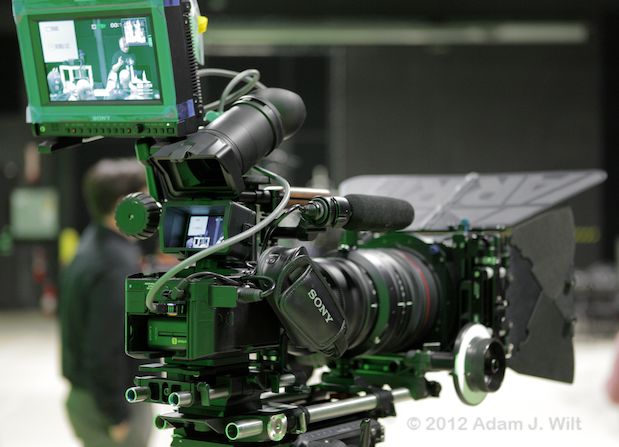
Another view of the FS100 with 18-85mm.
See that tiny little F770 battery buried in the back of the FS100? It ran the camera for over four hours. Normally I’d have a RED ONE where the FS100 is, and I’d be changing out massive RED BRICKs every hour or so. Running this big rig for half a day on a tiny camcorder battery was a hoot!
See Also:
Review: Sony NEX-FS100 “Super35” LSS AVCHD Camcorder
Quick Look: Three new E-Mount Primes
Quick Look: Alpha A-mount Lenses on the FS100
Quick Look: Variable ND Filters
Disclosure: Sony shipped me an NEX-FS100UK, several Alpha lenses and adapters, two variable ND filters, two PL-mount adapters, and a PVM-740, which I returned at my own expense ($386.85, insured) at the conclusion of testing.
Caleb Crosby shipped me a collection of ShotGrip components for review, which I returned at my own expense ($30.46, insured).
I bought the RainbowImaging Nikon-to-E-mount adapter with my own money.
The Arri, RED, and Element Technica bits were borrowed from Meets the Eye, where I work.
No material connection exists between me and Sony, or any of the other vendors mentioned in the article. No one has offered any payments, freebies, or other blandishments in return for a mention or a favorable review.

Filmtools
Filmmakers go-to destination for pre-production, production & post production equipment!
Shop Now